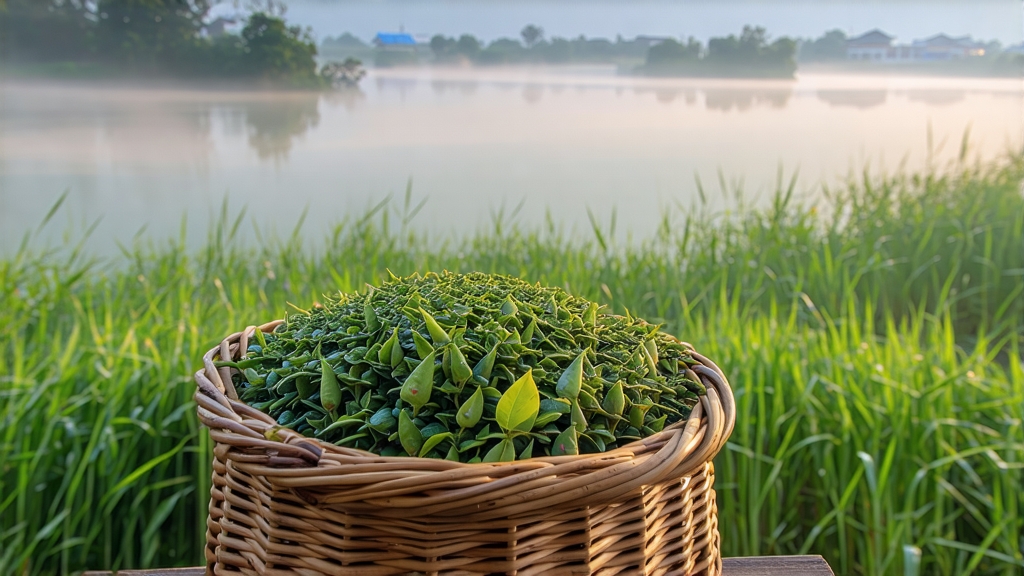
Among the pantheon of Chinese green teas, none carries a name as lyrical or a leaf as diminutively elegant as Biluochun. Literally “Green Snail Spring,” the tea is prized for its tight spiral shape, downy silver tips, and a fragrance so naturally sweet that early Ming poets claimed it “perfumed the lake air long before the pot was warmed.” Grown almost exclusively on the mist-laden hillsides of Dongting Mountain at the edge of Lake Tai in Jiangsu province, Biluochun is both a sensory jewel and a living chapter of Chinese tea history, one that rewards the patient drinker with layers of orchid, apricot, and steamed pea shoots in every sip.
Historical whispers place Biluochun’s birth during the late Tang dynasty, but verifiable records begin in the Ming Wanli era (1573–1620). Local legend tells of a tea-picking girl who hid tender leaves between her breasts while crossing the mountain; body heat lightly oxidized the buds, releasing an intoxicating aroma that startled passing monks. Whether myth or marketing, the story underscores the tea’s signature trait: an almost perfumed bouquet that seems impossible to coax from mere leaves. Imperial favor arrived quickly—by the Qing Kangxi reign (1662–1722) the leaf was tribute tea, and the emperor himself is said to have renamed it from “Xia Sha Ren Xiang” (“scary fragrance”) to the gentler “Biluochun,” referencing its snail-like curl and spring harvest.
Strictly speaking, Biluochun is not a single cultivar but a micro-terroir style. The original genetic stock is a small-leaf Camellia sinensis var. sinensis locally called “Xiao Ye.” Over centuries, clonal selections such “Dongting #1,” “Dongting #2,” and the more recent “Su Cha #3” have been released, each balancing yield, frost resistance, and aromatics. Purists, however, insist that only tea picked within a 5-km radius of Dongting’s two peaks—Dongshan (East Mountain) and Xishan (West Mountain)—deserves the name. Here, acidic sandy loam, constant lake humidity, and temperature inversions create a natural greenhouse that forces slow growth, concentrating amino acids and fragrant volatiles. Yields are tiny: 70,000 buds make barely 500 g of finished tea, explaining why top-grade Biluochun can rival silver in price.
Harvest unfolds between the Qingming and Grain Rain solar terms (early April to early May). Pickers rise before dawn, waiting for mountain mist to lift just enough to reveal the “one bud with one unfolding leaf” standard. Leaves must be 1.5–2 cm long, still turgid from night dew, because any wilting in the basket diminishes the hallmark vibrancy. Within two hours the load is carried to the village workshop, a modest brick building whose windows are sealed to block stray odors from peach and loquat orchards outside.
Crafting Biluochun is a ballet of heat, pressure, and timing that lasts roughly 40 minutes but is divided into six meticulous stages. First, “kill-green” (shaqing) occurs on a tilted iron pan heated to 180 °C. The tea master tosses 250 g of buds in a figure-eight motion for 3–4 minutes, relying on bare-hand contact to judge leaf pliability; when the surface turns sticky-slick, enzymes are denatured and grassy notes are purged. Immediately the temperature drops to 80 °C for rou-nian (soft kneading), where fingers roll the leaf against the pan in concentric circles. This is the moment the spiral is born: gentle pressure plus residual moisture causes the bud to curl inward like a snail shell. A 30-second “lift and shake” follows, separating any clumps while further drying. The cycle—heat, roll, shake—repeats three times, each pass lowering temperature by 10 °C until moisture falls below 30 %. Finally, a quick 60 °C finish dries the tea to 6 % moisture, locking in the downy white tips that give premium grades their silvery sheen. Throughout, the master listens: a rustling like dry beans signals readiness, whereas a dull thud means over-roasting and a lost opportunity for re-infusion.
Because Biluochun is so delicate, water choice and temperature are non-negotiable. Ideal water is spring or filtered, with a neutral pH and total dissolved solids below